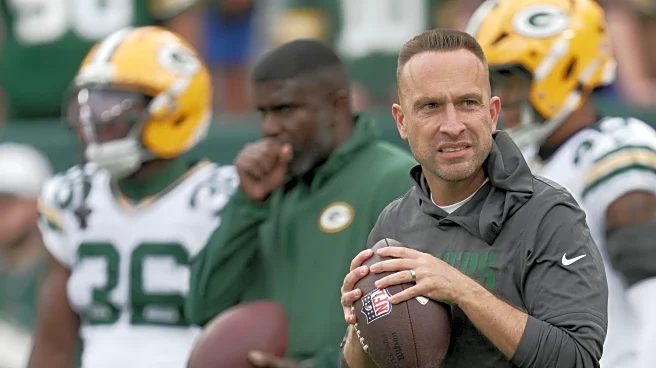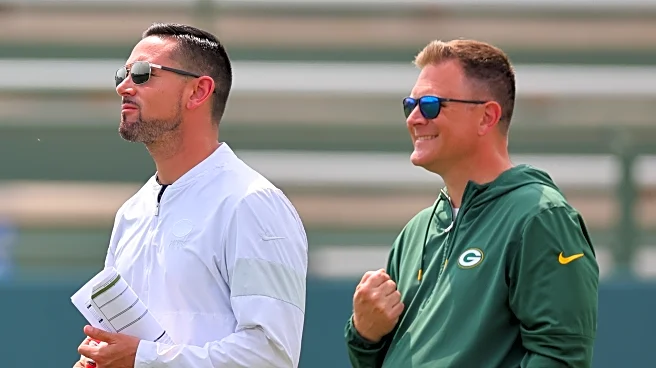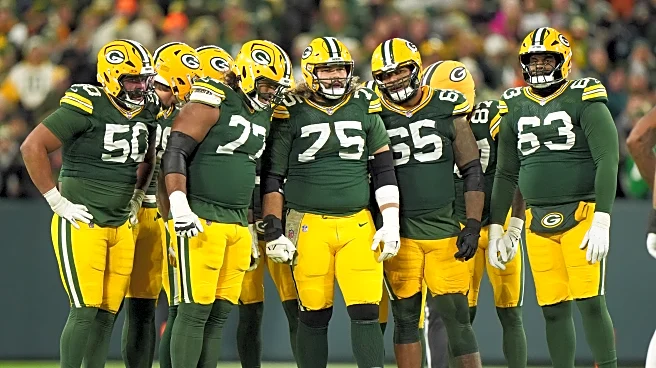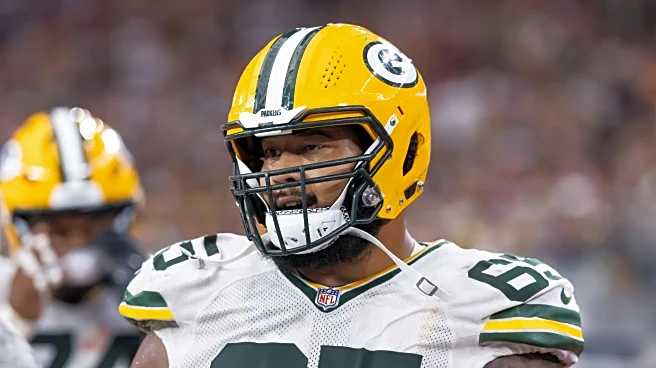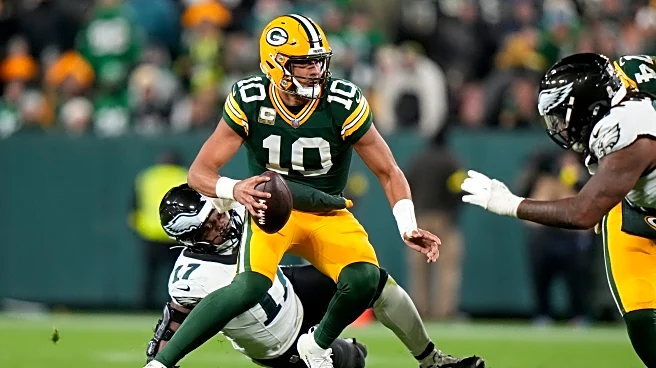There’s so much talk about the Green Bay Packers’ offensive line that I just wanted to finally collect all my thoughts together on the team’s recent pivot at the position. As someone who has followed the Packers’ draft
trends since the start of the Ted Thompson era, maybe too closely for my own good health, there has been a significant change in how the team approaches the position, which has been reflected in both their drafts and in free agency. Recently, the team has wanted to add weight at the position, likely due to their changing schemes in the run game (more on that later), but what we can all agree on right now is that their run game isn’t working.
Just to paint the picture of the Packers’ run game failures — so we can get it out of the way — running back Josh Jacobs has 608 rushing yards this season, but only 99 of those yards are before contact, according to NFL Pro, the league’s own player-tracking platform. On average, Jacobs is averaging 0.6 yards before contact per carry. 15 quarterbacks, including Green Bay’s Jordan Love, have more yards before contact than Jacobs this season. Backup Arizona running back Emari Demercado, who has just 26 carries on the year, has more yards before contact (107) than Jacobs in 2025.
Now that we’ve established a lack of effectiveness on the ground, let’s focus on the offensive line and what has changed recently.
Until recently, the Packers were known for drafting undersized but high-quality pass-protecting college tackles on Day 3 of the draft. They also didn’t hesitate to move those players to guard or center, either. This method worked because Green Bay’s offensive scheme leaned into the passing game (Mike McCarthy was viewed as innovative for transitioning the West Coast Offense into shotgun at one point in his career; you have to believe me on this) and zone run schemes. This eliminated the need for 320-pound offensive linemen who needed to move 330-pound defensive tackles off the ball for gap scheme runs to work.
The front office’s ability to hammer that market inefficiency is maybe the second-most important reason why the Packers have been so consistent over the last 20-plus years. Number one, obviously, is hitting on starting quarterbacks in the draft and developing those passers.
The offensive line pivot: Green Bay gets big
Pro Football Reference only has Green Bay’s snap counts dating back to the 2012 season, so I can’t go all the way back to the start of the Thompson era in 2005. What I will say, though, is that the Packers never had a significant full-time starter on the offensive line who weighed 320 pounds or more (based on combine and pro day weigh-ins) from 2012-2023. Over that time, the team went a combined 120-73-2 over those years, including three straight 13-win seasons to start the Matt LaFleur era.
The type of linemen that Green Bay now adds to the roster is much heavier now though. Right now, the Packers’ top eight offensive linemen (Rasheed Walker, Aaron Banks, Elgton Jenkins, Jordan Morgan, Zach Tom, Sean Rhyan, Darian Kinnard and Anthony Belton) average out to 320.5 pounds, again, based on their combine/pro day weights. Just this past year, Green Bay has added Anthony Belton (336 pounds), Kinnard (328), Banks (325) and John Williams (322) to the team.
All of those players are much bigger than David Bakhtiari (299), Corey Linsley (296), J.C. Tretter (307) and Zach Tom (307), the Day 3 steals that were once one of the defining traits of the franchise.

The chart above shows the average weights, on a per-snap basis, of the Packers’ lines from the 2012 season through Week 10 of 2025. As you can see, they’ve increased the weight of their linemen in three consecutive seasons, and the last two years are much heavier than the average line. And, honestly, if you look at some of the pre-draft visitors they’ve brought in, this number might only increase with the 2026 class. More on that later.
If I had the data on the earlier Thompson-era teams’ snaps, I bet that they would look much like the 2012-2023 seasons, too, compared to the last two years. I’m not trying to cherry-pick here. If you have those numbers, feel free to leave them in the comment section.
Why did the Packers’ line get so heavy?
Here’s something that you need to remember: General manager Brian Gutekunst took over in 2018. Head coach Matt LaFleur took over in 2019. They were both fine playing lighter lines back in 2019, 2020 and 2022, three of the team’s four lightest lines since 2012. Adam Stenavich was in his first year as the offensive coordinator of the team in 2022, again, one of the lighter years for the Packers’ line.
I don’t think anyone in Green Bay got a job and said, “Hey, let’s stop getting a lot of value out of undersized Day 3 linemen.” I don’t think you can even pinpoint exactly who made this decision for the Packers, but here’s something I do know: The offensive scheme has changed in recent years.
When LaFleur first took over in Green Bay, the hope was that he would be the next Sean McVay, who at the time had found success running outside zone, bootlegs off of outside zone and jet sweeps off of outside zone with the Los Angeles Rams. In LaFleur’s first year as the head coach for the Packers, Green Bay led the NFL in zone rushing, 70 percent of their overall handoffs.
In Green Bay’s most recent loss to the Philadelphia Eagles, I can only remember the team running outside zone twice (off the top of my head — and I don’t want to have to watch the game a third time to get this number right), a play where left guard Aaron Banks (325 pounds) wasn’t able to keep up laterally and ended up allowing Josh Jacobs to get hit in the backfield and once where Banks was unable to successfully climb up to the linebacker level, allowing the linebacker to have a clean runthrough and force contact in the backfield. The plays I’m talking about are the first and third plays in the video linked below if you want to see them yourself:
Running outside zone, a play that relied more on athleticism than strength, was one way the Packers “got away” with playing undersized linemen in the first place. Now, the team hardly ever calls the play. On the ground, they run duo, inside zone and plays with downblocks (like counter and pin-and-pull sweeps) far more often. All of those plays rely on vertical, not lateral, displacement to work. Unfortunately for Green Bay’s pre-2022/2023 market inefficiency, vertical displacement usually takes more size and strength, while lateral displacement requires more athleticism.
In short, I would guess that at some point, be it LaFleur or Stenovich or another person in the building, someone on Green Bay’s offensive staff decided that they wanted to be a vertical displacement team. That information was accepted by the front office, which then began its search for larger linemen, which sort of wiped out the undersized tackle mold that the team had been so good at drafting in the past.
That is a guess. This is not me reporting that as fact. Based on the changes we’ve seen, in both scheme and talent acquisition, though, it’s what makes the most sense to me. Feel free to bring me your alternative theories.
Packers offensive line pre-draft visitors
The 2021 NFL draft was full of draft busts across the board, in part because scouts were unable to visit schools and gather information like they had previously, due to the pandemic. In 2022, the Packers responded to the change in the scouting world by taking a very different approach with pre-draft visitors. Previously, the team had mostly used pre-draft visits to check boxes on players who had character/medical questions or use visits as a recruitment tool for undrafted free agency. That goes back to the Ted Thompson days.
Since 2022, coming out of the pandemic 2021 draft cycle — when all pre-draft visits were still done virtually — the Packers began to start tipping their hand. Over the last four seasons, one-quarter of Green Bay’s pre-draft visitors have ended up on their roster, at least eventually. If they didn’t get them on draft day, they often try to target these players later down the line, like when the Packers traded for Darian Kinnard at the cutdown deadline this year. So that one-quarter number might rise over the coming seasons, too.
One-quarter might not seem very impressive to you, but it’s a huge tell that Green Bay is now bringing in players that they actually want to draft (or sign in undrafted free agency), rather than to just cross them off of their board for medical/character concerns, as was often the case before 2022. One of four players landing in Green Bay is a huge hit rate when 31 other teams are looking to add talent in the draft, too. Some of the players the team brings in aren’t even available for the Packers because they’re drafted before Green Bay is ever even on the clock. More on that later.
Former Packers pre-visitors include:
- WR Matthew Golden
- DT Devonte Wyatt
- WR Christian Watson
- LB Edgerrin Cooper
- OL Anthony Belton
- WR Savion Williams
- LB Ty’Ron Hopper
- WR Romeo Doubs
- OL Darian Kinnard (traded for this summer)
- TE Josh Whyle (picked up after cutdowns this summer)
- WR Dontayvion Wicks
- S Kitan Oladapo
- DT Karl Brooks
- TE John FitzPatrick (picked up mid-season last year)
- OL Rasheed Walker
We’re in an era where Green Bay tells the world who they are interested in for the draft before the draft starts. So, if they’ve brought offensive linemen in on visits, we should be able to see what type of linemen they’re interested in during this period where their line has grown in size, right?
Let’s take a look at the linemen that the Packers have brought in on visits over the last four years and were actually selected in the draft. This should give us some more information on whether they have pivoted away from the Bakhtiari/Tom type of linemen and are really just looking at guys who are around 320-ish pounds.
Packers draftable OL pre-draft visitors (2022-2025 classes)
- Darnell Wright (#10, 2023): 333 pounds
- Amarius Mims (#18, 2024): 340
- Tyler Smith (#24, 2022): 327
- Tyler Guyton (#29, 2024): 322
- Josh Simmons (#32, 2025): 317
- Anthony Belton (#54, 2025): 336
- Ed Ingram (#59, 2022): 312
- Abraham Lucas (#72, 2022): 316
- Kiran Amegadgie (#75, 2024): 323
- Zak Zinter (#85, 2024): 309
- Giovanni Manu (#126, 2024): 353
- Atonio Mafi (#144, 2023): 329
- Darian Kinnard (#145, 2022): 328
- Rasheed Walker (#249, 2022): 324
- John Williams (#250, 2025): 322
Out of these 15 visitors, the average weight is 319 pounds, even higher than the Packers’ weight-adjusted snaps this year. Of the 15, 11 are over 320 pounds, and none of them are under 309 pounds. Tom, Bakhtiari, Linsley and Tretter were all smaller than any of the drafted linemen whom Green Bay brought in as visitors over the last four seasons. In this group, even the likes of Bryan Bulaga, T.J. Lang and Josh Sitton, who used to be big for the Packers’ undersized lines in the past, would be considered on the smaller end.
Here is what I can actually report. I have been told that the Packers would have used their first-round pick in 2023 on Darnell Wright, a 333-pounder, had he been available. Instead, the team took defensive end Lukas Van Ness. I was also told that Amarius Mims (340 pounds) would have been their pick in the first round of the 2024 draft, rather than Jordan Morgan, if he had been available, too. Mims was not likely to slip to Green Bay’s range (he went seven picks before Morgan), but Wright went off the board just three picks before the Packers selected Van Ness.
For fun, since we’re rambling about draft could-have-beens, the Arizona Cardinals (#27, but tried to jump Green Bay), Baltimore Ravens (#30) and Washington Commanders (were prepared to move up from the second round) were all trying to pick up Morgan in the 2024 draft. Dallas Cowboys owner Jerry Jones, who took Tyler Guyton 29th overall (four picks after Morgan), is also on record that Morgan was in the group of four players that the team was hoping to pick with their first-round selection. Three of the four, including Morgan, were gone by the time the Cowboys were on the clock, leaving Jones with just Guyton as an option. I cannot believe Jerry is so open about everything.
tl;dr
So what do I think about the Packers’ offensive line situation? I think for years, they’ve leaned out of one of their biggest advantages from a scouting perspective: Being able to identify undersized pass-protectors (usually college tackles) who can survive in the NFL by zone blocking in the run game. The pivot away from a heavy outside zone run scheme on offense has forced the team to get bigger, which means that Green Bay can no longer wait for a Tom or Bakhtiari to fall to them anymore, since the front office is now feeding linemen into a scheme that demands that their linemen must get vertical knockbacks to make the run game successful.
In this system, maybe Bakhtiari is a center, not a tackle, which was the opinion of many analysts when he was a draft prospect back in 2013. It’s just a different world that the Packers are operating in right now.
2026
There’s no doubt that the team bombed with the Aaron Banks signing, at least that’s what it’s looking like right now. You’re more than free to light the front office up for that. I wasn’t a fan of the signing from the start and described the signing at with the term “sticker shock” at the time. With that being said, I do think Jordan Morgan will look a lot better at his natural position of left tackle in 2026 when he takes over for Rasheed Walker. I’m not out on Anthony Belton, who I believe should probably be the team’s starting right guard next year, either. Is there some optimism left? Yes.
The reality of the situation, though, is that the Packers are likely to lose three contributing offensive linemen in 2026 free agency (Walker, Rhyan and Kinnard) and another (Jenkins) as a cap casualty. In my opinion, there’s far too much optimism right now that Green Bay will be able to backfill these losses with Day 3 selections, as fans of the team who haven’t caught onto the change in strategy on the offensive line are hoping for a Bakhtiari, Tom, Tretter, Linsley, Lang or Sitton that the team no longer seems too interested in because they are preceived to be too small for the current run scheme.
And with only two picks in the top 120 selections of the 2026 draft, as it stands today, double-dipping early at the position for Day 1 contributors also seems highly unlikely. Added on top of that, additions in free agency would only offset compensatory picks in 2027, which the Packers will desperately need, and would take a mortgaging of even more of the team’s future to create short-term cap space, as Green Bay is expected to start the year with around $0 of effective cap space, even after the Jenkins release — should they sign captains linebacker Quay Walker and tight end Tucker Kraft to extensions. (Hint: They probably will.)
Based on the team’s actions since 2022, it’s far more likely that the Packers will look for one 320-plus-pound linemen early on in the draft, a type of player who would draw more interest from more clubs than the undersized linemen that used to be Green Bay’s market inefficiency. Because every team is looking to add athletic and big linemen, there’s less of a chance that the Packers will be able to add “value” in the draft at the position like they have in the past. Maybe the Packers pivot back to their pre-2022/2023 plan, but that’s not the path that they’re on right now. And if they do pivot, it will probably make the Banks signing look even worse, as this scheme, if you can believe it, actually works into his strengths.
Maybe the team makes a change at offensive line coach. Luke Butkus, who has only been the number one offensive line coach just twice previously in his career (two stints at his alma mater, Illinois), might have to go. Green Bay has sort of made their bed already with the pivot on the line, so searching for a different voice in the room might be their best option for optimism up front, if LaFleur is indeed the head coach still in 2026.
Don’t expect Stenovich to go back to offensive line coach, though. Line coach is often viewed as a dead-end job, because so few of those coaches get the opportunity to rise to offensive coordinator. Stenavich was able to climb the ladder against the odds. Last year, he took interviews as a play-calling offensive coordinator with the Seattle Seahawks and for the Chicago Bears’ head coaching opening. With career aspirations, don’t make the mistake of assuming that he’ll just be content with a demotion.
Depending on your point of view, a change of voice in the offensive line room is either the exact thing that this team needs, or it’s just the death rattle of an offense headed down a bad path.
This is the trade-off of getting bigger on the line and wanting to run more vertical blocking schemes. The old market inefficiency is gone, and they’ve struck out on (at least) an expensive swing.


